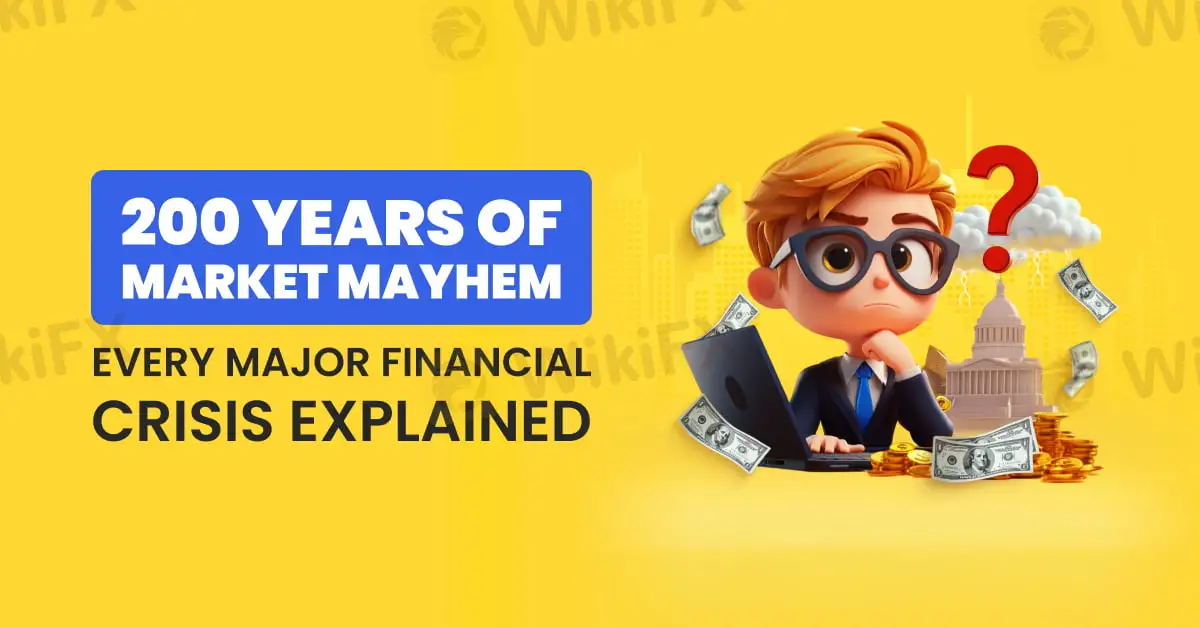简体中文
繁體中文
English
Pусский
日本語
ภาษาไทย
Tiếng Việt
Bahasa Indonesia
Español
हिन्दी
Filippiiniläinen
Français
Deutsch
Português
Türkçe
한국어
العربية
200 Years of Market Mayhem: Every Major Financial Crisis Explained
Abstract:Financial crises have shaped economies for centuries, often leaving a trail of devastation in their wake. While each crisis has its own unique causes, recurring themes, such as speculation, regulatory failures, and external shocks, continue to threaten global markets. This article explores the most significant financial collapses in history, revealing the patterns that link past crises to modern financial instability.

Financial crises have shaped economies for centuries, often leaving a trail of devastation in their wake. While each crisis has its own unique causes, recurring themes, such as speculation, regulatory failures, and external shocks, continue to threaten global markets. This article explores the most significant financial collapses in history, revealing the patterns that link past crises to modern financial instability.

The first recorded financial crisis in the United States occurred in 1792, triggered by speculative trading in government bonds. A wave of panic led to bank failures, forcing the newly established U.S. financial system to stabilise through the intervention of Alexander Hamilton. Decades later, the 1837 U.S. Banking Crisis saw widespread bank failures after a speculative land boom collapsed, deepening a long economic downturn.
By 1857, a combination of rail industry overexpansion and declining European demand for U.S. goods led to another financial crash, proving that global markets were becoming increasingly interconnected. This was followed by the 1873 Long Depression, a pan-European financial crisis sparked by bank failures in Austria and the collapse of the U.S. railroad industry.

As financial markets grew, crises became more complex. The 1893 U.S. Banking Crisis saw the collapse of over 500 banks due to a failing gold standard and declining investor confidence. Decades later, the infamous 1929 Great Depression began with the Wall Street Crash, leading to mass unemployment and a prolonged economic downturn that lasted a decade.
By the 1970s, external shocks played a larger role in financial instability. The 1973 Oil Crisis was triggered by an OPEC embargo, leading to soaring fuel prices and inflation. The 1979 Second Oil Crisis compounded these problems, causing a global economic slowdown.

As global markets became more intertwined, financial crises took on a new dimension. The 1982 Latin American Debt Crisis arose when major South American economies, burdened by unsustainable debt, defaulted on their loans. The shockwaves were felt worldwide, reinforcing the risks of excessive borrowing.
The 1987 Black Monday crash saw stock markets collapse globally, with the Dow Jones losing 22% of its value in a single day—an early warning of the risks associated with computerised trading. The 1992 European Exchange Rate Mechanism Crisis followed, as speculative attacks on the British pound forced the UK to withdraw from the ERM.
By 1994, Mexicos economy was in turmoil due to unsustainable debt and investor panic, leading to the Tequila Crisis, which necessitated an emergency bailout. Three years later, the 1997 Asian Financial Crisis saw massive currency devaluations across Thailand, Indonesia, and South Korea, exposing weaknesses in emerging market economies.

The 2000 Dot-Com Bubble Burst wiped out billions in speculative internet-based stocks, underscoring the dangers of overhyped technology investments. Just eight years later, the 2008 Global Financial Crisis, driven by subprime mortgage lending and excessive risk-taking, plunged the world into a deep recession. The fallout led to sweeping banking regulations and government bailouts.
In 2010, the European Sovereign Debt Crisis emerged as countries like Greece, Portugal, and Spain struggled with debt repayment, testing the resilience of the Eurozone. Most recently, the 2020 Covid-19 Global Financial Crisis caused markets to crash as the pandemic shut down economies worldwide, prompting unprecedented fiscal stimulus and monetary interventions.

Financial crises are inevitable, but history shows that regulatory oversight, responsible investment strategies, and early intervention can mitigate their impact. As markets evolve, understanding past collapses remains crucial in preventing the next economic disaster.

Disclaimer:
The views in this article only represent the author's personal views, and do not constitute investment advice on this platform. This platform does not guarantee the accuracy, completeness and timeliness of the information in the article, and will not be liable for any loss caused by the use of or reliance on the information in the article.
Read more

The Ultimate Guide to Automated Forex Trading in 2025
Modern markets are revolutionized by automated trading systems, which now execute 70-85% of all transactions. These advanced automated trading software solutions, commonly called trading robots or Expert Advisors (EAs), leverage algorithmic precision for automatic trading across forex, stocks, and commodities 24/7. By removing emotional interference and executing trades in microseconds, auto forex trading platforms create fair opportunities for all market participants. For those new to automated trading for beginners, these systems provide disciplined, backtested strategies while significantly reducing manual effort.

Will natural disasters have an impact on the forex market?
The forex market is known for its rapid responses to global events, but the influence of natural disasters, such as earthquakes and typhoons, can be less straightforward. While headlines may scream about catastrophic damage and economic disruption, the long-term effects on currency values often depend on a blend of immediate shock and underlying economic fundamentals.

Philippines Deports 29 Indonesians Linked to Online Scam Syndicate in Manila
Online scam groups in the Philippines trick Filipinos into gambling and love scams, from Manila to Bacolod, causing trafficking and pain as police fight back.

Why does your mood hinder you from getting the maximum return from an investment?
Investment decisions are rarely made in a vacuum. Aside from the objective data and market trends, our emotions—and our overall mood—play a crucial role in shaping our financial outcomes. Whether you’re feeling overconfident after a win or anxious after a loss, these emotional states can skew your decision-making process, ultimately affecting your investment returns.
WikiFX Broker
Latest News
How Crypto Trading Transforms FX and CFD Brokerage Industry
UK would not hesitate to retaliate against US tariffs - No 10 sources
FCA Warns Against 10 Unlicensed or Clone Firms
CySEC Warns Against 14 Unlicensed Investment Websites
Top Currency Pairs to Watch for Profit This Week - March 31, 2025
Will natural disasters have an impact on the forex market?
Philippines Deports 29 Indonesians Linked to Online Scam Syndicate in Manila
Navigating the Intersection of Forex Markets, AI Technology, and Fintech
Exposed: Deceptive World of Fake Trading Gurus – Don’t Get Fooled!
AI-Powered Strategies to Improve Profits in Forex Trading
Currency Calculator








